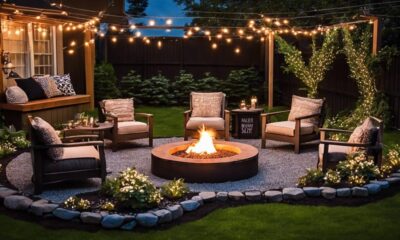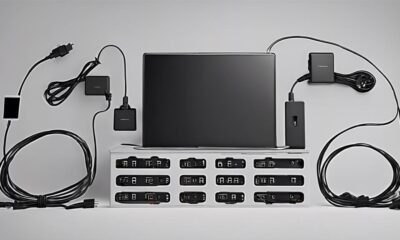Southeast Asia Decor
Why Balance Matters in Feng Shui Interiors
Discover how achieving balance in feng shui interiors can transform your space, enhancing energy flow and well-being in ways you never imagined.

Balance matters in feng shui interiors because it creates harmony and promotes positive energy flow. By arranging your space thoughtfully, you enhance the flow of chi, leading to a more serene atmosphere. Incorporating the five essential elements—Fire, Earth, Water, Wood, and Metal—helps achieve this balance while aligning with the yin and yang principle. Decluttering and maintaining clear pathways also play significant roles in ensuring effective energy movement. Overall, balanced environments not only elevate your well-being but also contribute to mental clarity and emotional health. Discovering practical ways to implement these principles can further enhance your space's energy.
Key Takeaways
- Balance in Feng Shui promotes positive energy flow, enhancing overall well-being and creating a harmonious environment.
- Achieving balance through the five elements fosters emotional stability and mental clarity in living spaces.
- The yin and yang principle emphasizes equilibrium, ensuring opposing forces coexist to create serenity and calmness.
- A well-balanced arrangement of furniture and decor supports a sense of control and stability, improving daily life.
- Incorporating natural materials and decluttering enhances liveliness, promotes effective chi flow, and nurtures connections with nature.
The Essence of Feng Shui

What makes Feng Shui more than just a design trend? It's the deep-rooted principles that emphasize balance and harmony in your living space. Feng Shui isn't just about aesthetics; it's about creating an environment that nurtures positive energy, or chi.
By understanding how to arrange your furniture and decor, you can enhance the flow of energy throughout your home. Incorporating elements like Indonesian decorative pillows can add vibrant colors and intricate patterns, further enhancing the overall ambiance and cultural depth of your space.
Central to Feng Shui are the five elements: Fire, Earth, Water, Wood, and Metal. Each element has unique properties that influence energy within your space. Balancing these elements can greatly affect your well-being, inviting tranquility and positivity into your life.
You'll also want to reflect on the yin and yang aspects, which represent dark and light, soft and hard, further promoting harmony in your environment.
Using tools like the Bagua map helps you identify areas of influence and prioritize chi flow. Effective practices, such as decluttering and utilizing natural materials, enhance energy and create a serene atmosphere.
Elements of Balance

Achieving balance in your living space involves harmonizing the five essential elements of Feng Shui: Fire, Earth, Water, Wood, and Metal. Each of these elements contributes unique energies that help create balance and harmony within your environment.
Understanding the yin and yang principle is fundamental, as it emphasizes the need for equilibrium between opposing forces, like light and dark or soft and hard materials. This balance fosters a peaceful space, much like the indoor-outdoor living concept found in Balinese design that promotes harmony with nature.
To enhance energy flowing throughout your home, arrange furniture to promote clear pathways and avoid clutter. This not only helps maintain the flow of chi but also aligns with the principles of Feng Shui.
Placing key pieces in a commanding position can create a sense of control and stability, which is essential for overall balance in a room.
Incorporating natural materials, such as wood and plants, strengthens your connection with nature while enhancing the energy flow. By embracing these elements, you're using ancient Chinese philosophy to create balance in your living space.
Ultimately, Feng Shui can bring a sense of well-being and tranquility, allowing you to enjoy a harmonious environment that supports your daily life.
Achieving Harmony in Design

When designing your space, harmony comes from the thoughtful arrangement of furniture and decor that enhances energy flow. By focusing on feng shui principles, you can create an environment that promotes good energy.
Start by balancing yin and yang elements in your interior design—soft materials paired with hard surfaces, and light colors contrasted with darker tones contribute to a serene atmosphere. Additionally, incorporating natural materials like wood and stone can enhance the connection to nature, creating a more grounded and peaceful environment traditional Indonesian style home decor.
Incorporating the five elements of feng shui—Fire, Earth, Water, Wood, and Metal—ensures each aspect of your design contributes to the overall balance and energy. Use the Bagua map to identify areas that need attention, allowing you to make targeted changes that support your goals and well-being.
Maintaining uncluttered spaces is essential for creating harmony and balance. Clutter disrupts the flow of energy, making it harder to feel relaxed in your surroundings.
Additionally, maximizing natural light not only enhances the beauty of your space but also greatly improves the flow of energy, fostering a tranquil atmosphere. By thoughtfully considering these aspects, you can achieve a harmonious design that enhances your life.
Practical Tips for Implementation

Implementing feng shui principles in your home can transform your space into a sanctuary of balance and positive energy. Start by decluttering your areas to promote a smooth energy flow (Chi). Clutter can block the effectiveness of feng shui, so a tidy environment is crucial. Next, use the Bagua map to identify which areas of your home influence key aspects of your life, like wealth and health.
Here's a quick guide to get you started:
| Action | Purpose |
|---|---|
| Decluttering | Promotes positive energy flow |
| Using the Bagua map | Targets specific life aspects |
| Furniture positioning | Creates a sense of control |
| Adding natural elements | Enhances liveliness and balance |
Position your furniture, especially beds and desks, in commanding positions facing the door to foster security. Incorporate natural elements like plants and water features to align with the wood and water elements in feng shui. Regularly maintain cleanliness to reinforce the calming atmosphere feng shui aims to achieve, making your home a true reflection of balance.
Impact on Well-Being

Creating a balanced environment through feng shui has a direct impact on your well-being. When you achieve balance, you promote the flow of positive energy, or Chi, which enhances mental clarity and reduces stress.
Incorporating unique decorative elements, such as traditional artistry from Indonesian decor masks, can add character to your space while celebrating cultural heritage. This can lead to improved emotional health, making it easier for you to navigate daily challenges.
Decluttering your space is essential for creating this balance. A clean, organized environment allows for unobstructed energy flow, helping to prevent feelings of overwhelm.
You'll notice that as you declutter, a sense of calm and order emerges, making it easier to focus on what truly matters.
Incorporating natural materials like wood and plants into your interiors can further enhance indoor energy. This connection to nature supports not just your physical health, but also fosters better communication and relationships among the people who share your space.
Frequently Asked Questions
Is Feng Shui About Balance?
Yes, Feng Shui's all about balance. You harmonize opposing forces like yin and yang, ensuring energy flows freely. By organizing your space and incorporating natural elements, you create an environment that feels peaceful and vibrant.
How to Balance Energy Feng Shui?
Think of a seesaw; it works best when both sides are equal. To balance energy in feng shui, incorporate yin and yang elements, use the Bagua map, and guarantee clear pathways for ideal energy flow.
What Is the Most Important in Feng Shui?
In feng shui, the most important aspect is achieving a harmonious flow of energy. You should focus on balancing the elements, decluttering your space, and positioning key furniture to create a supportive environment for your well-being.
How to Balance Too Much Wood in Feng Shui?
To balance too much wood in feng shui, you can add fire elements like red decor, incorporate metal accents to weaken wood energy, and introduce water features for nourishment while reducing heavy wooden items in your space.
Conclusion
In the world of feng shui, balance is like a gentle breeze that carries peace into your home. By understanding the essence of balance and incorporating its elements into your design, you create a sanctuary that nurtures your well-being. As you implement these practical tips, you'll find your space transforming into a harmonious retreat. Embracing this balance not only enhances your interior but also revitalizes your spirit, reminding you that a well-designed space can profoundly affect your life.
- About the Author
- Latest Posts
Introducing Ron, the home decor aficionado at ByRetreat, whose passion for creating beautiful and inviting spaces is at the heart of his work. With his deep knowledge of home decor and his innate sense of style, Ron brings a wealth of expertise and a keen eye for detail to the ByRetreat team.
Ron’s love for home decor goes beyond aesthetics; he understands that our surroundings play a significant role in our overall well-being and productivity. With this in mind, Ron is dedicated to transforming remote workspaces into havens of comfort, functionality, and beauty.
Southeast Asia Decor
What Are Key Elements for Feng Shui Interiors?
Feng Shui interiors thrive on five key elements that create harmony; discover how to transform your space into a sanctuary of balance.

To create a balanced Feng Shui interior, focus on the five essential elements: Wood, Fire, Earth, Metal, and Water. Each element brings unique qualities, so incorporate natural materials and colors that resonate with these energies. Mindful furniture placement is vital; arrange pieces in a way that promotes flow and security. Keep your space decluttered to maintain energy movement and clarity. Emphasize natural light to uplift mood and enhance harmony. Finally, personalize your decor to guarantee it reflects your values and aspirations. There's more to explore about how to achieve a truly harmonious space.
Key Takeaways
- Incorporate the five elements—Wood, Fire, Earth, Metal, and Water—to create balance and harmony in the space.
- Use a color palette that reflects each element: green for Wood, red for Fire, yellow for Earth, white for Metal, and blue for Water.
- Arrange furniture in a commanding position, facing the entrance to promote security and awareness.
- Maintain a clutter-free environment to ensure smooth energy flow and prevent stagnation.
- Optimize natural light through window placement and mirrors to enhance energy and uplift mood.
Understanding Feng Shui Basics
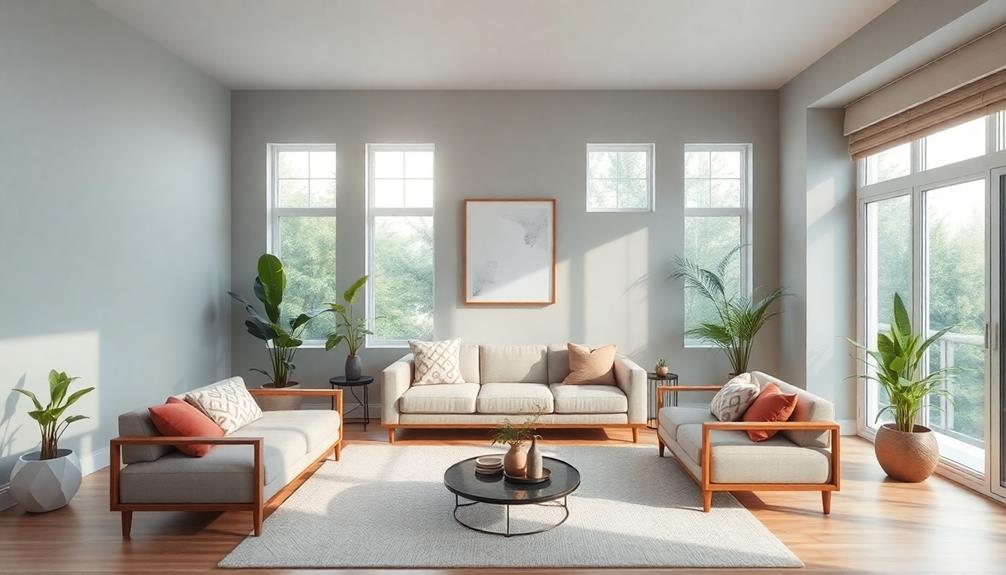
Feng Shui, often regarded as the art of placement, is all about creating a balanced and harmonious environment. This ancient practice emphasizes the flow of energy, or Chi, in your living space. To achieve this, you need to understand the five elements: Wood, Fire, Earth, Metal, and Water. Each element holds unique qualities and energies that influence your surroundings.
Balancing the elements is essential; when they work in harmony, you invite positive energy into your home. Incorporating natural materials and earthy tones can enhance this balance, similar to Balinese design principles that promote tranquility and connection to nature.
Start by considering your furniture placement. Positioning your furniture in a "commanding position" allows you to see the entrance, providing a sense of security and control over your space.
Decluttering is another vital aspect; removing unnecessary items promotes smooth energy flow and prevents stagnation.
Additionally, color psychology plays a significant role in Feng Shui. The colors associated with the five elements can evoke desired emotions and enhance the overall energy of your interiors.
The Five Key Elements
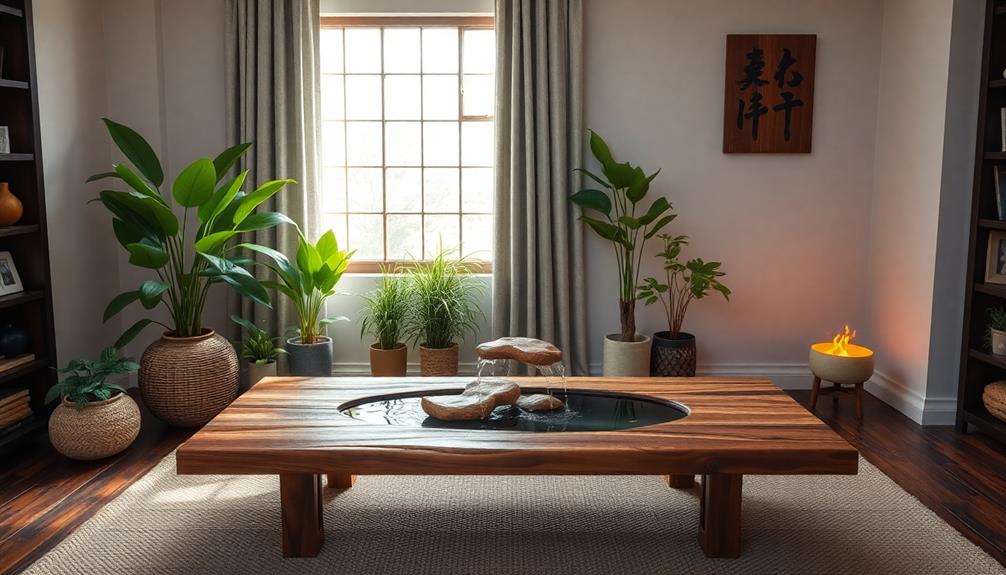
Understanding the five key elements—Wood, Fire, Earth, Metal, and Water—can transform your living space by influencing its energy.
Each element brings unique qualities that help you achieve balance and harmony in your home. For instance, incorporating vibrant colors and intricate patterns through items like Indonesian decorative pillows can enhance the Wood element and stimulate creativity.
Elemental Influence on Spaces
The essence of your living space can be transformed by the five key elements—Wood, Fire, Earth, Metal, and Water—each bringing unique qualities and energies that shape your environment.
Understanding how to incorporate these elements can foster a harmonious atmosphere that supports your well-being. For instance, in traditional Indonesian style home decor, natural materials and open spaces can enhance the influence of these elements.
- Wood: Symbolizing growth and liveliness, Wood encourages creativity. Use plants and natural materials in shades of green and brown to enliven your space.
- Fire: Associated with passion and inspiration, Fire adds energy. Integrate red or orange hues through candles and warm lighting to invigorate your surroundings.
- Earth: Representing stability, Earth nourishes your environment. Incorporate square shapes and natural materials like clay and stone in yellow and beige tones for a grounding effect.
- Metal: Promoting clarity and organization, Metal enhances focus. Use white and gray colors and introduce round shapes or metallic accents to improve your mental clarity.
Achieving Balance and Harmony
Achieving balance among the five key elements—Wood, Fire, Earth, Metal, and Water—is crucial for creating a harmonious living space. Each element has unique qualities that influence the flow of energy and emotional well-being. You'll want to guarantee that no element is overrepresented or underrepresented, as this can lead to negative energy and disrupt the atmosphere of your home.
To help you visualize how to balance these elements, consider the following:
| Element | Corresponding Colors |
|---|---|
| Wood | Green, Brown |
| Fire | Red, Orange |
| Earth | Yellow, Beige |
| Metal | White, Gray |
| Water | Blue, Black |
Incorporate these colors into your decor to enhance positive energy. Also, pay attention to how these elements interact, following their generating and overcoming cycles. Regularly assess your space and declutter to maintain a balanced environment that allows energy to flow freely. By thoughtfully arranging the elements of feng shui in your home, you create a sanctuary that supports stability and liveliness.
Importance of Balance in Design

In any space, maintaining balance in design can greatly enhance your well-being and emotional state. Achieving this balance involves a thoughtful integration of the five elements of Feng Shui—Wood, Fire, Earth, Metal, and Water.
When these elements are proportionately represented, they support ideal energy flow and foster a nurturing atmosphere. Additionally, incorporating aspects of tropical villa plans can further enhance the harmony of your living space through open layouts and natural materials.
Here are four key aspects to keep in mind:
- Element Representation: Verify each element is present; too much of one can lead to negative traits like anger or stagnation.
- Natural Materials: Incorporate natural materials that resonate with each element, enhancing harmony and connection to nature.
- Energy Flow: Regularly declutter and organize your space to prevent stagnation and maintain a smooth energy flow.
- Color Selection: Choose colors that correspond to each element, like green for Wood and red for Fire, to evoke specific emotional responses.
Color Significance in Feng Shui
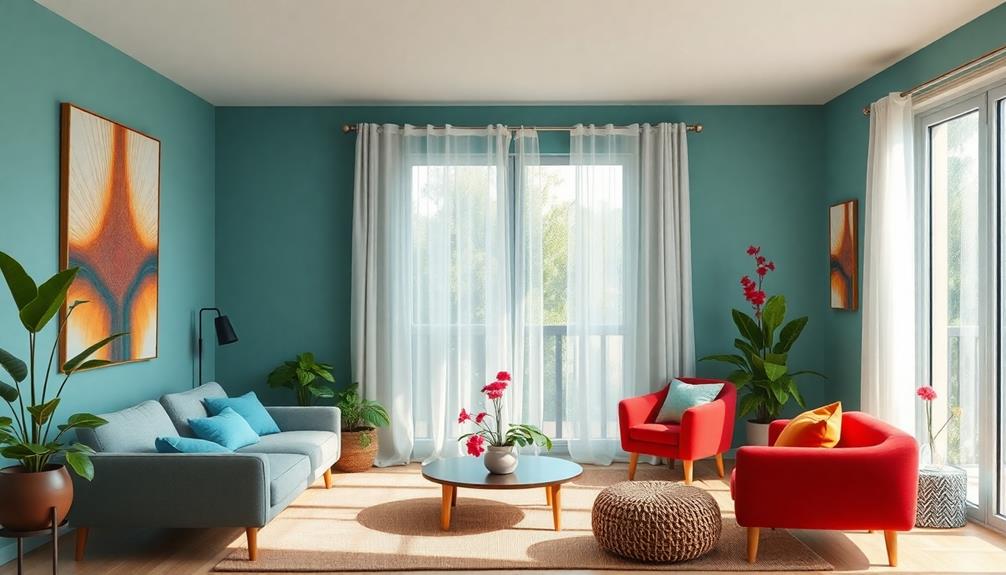
Colors play an essential role in Feng Shui, acting as powerful tools to influence mood and energy within a space. Each color corresponds to specific elements and qualities, creating distinct atmospheres.
For instance, earthy tones like yellow and beige evoke stability and nourishment, grounding the energy in your home. Traditional Indonesian housing often reflects cultural symbolism in its design, showcasing how distinct architectural styles can harmonize with natural elements.
If you want to foster growth and liveliness, consider incorporating shades of green and brown, which represent the Wood element.
The Water element is represented by colors like blue and the color black, symbolizing fluidity and emotional balance. You can use these colors in areas designated for communication or career motivation to enhance flow and connection.
On the other hand, colors associated with the Metal element, such as white and gray, promote clarity and organization, making them ideal for workspaces.
Furniture Placement and Flow
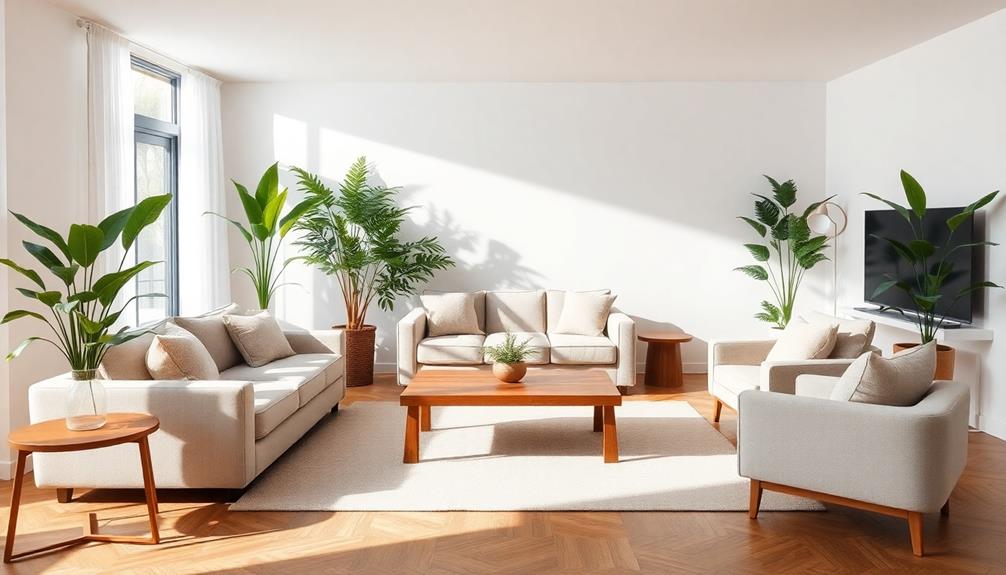
Creating a harmonious environment goes beyond color choices; it also involves thoughtful furniture placement. Proper arrangement can greatly enhance the energy flow throughout your space, particularly in the living room where social interactions thrive. Incorporating elements of modern tropical aesthetics can also enhance the connection between your indoor and outdoor spaces.
Here are key tips to take into account:
- Clear Pathways: Make sure furniture placement allows for unobstructed movement, promoting a smooth flow of energy (Chi).
- Commanding Position: Arrange seating to face the entrance. This creates a sense of security and awareness for everyone in the room.
- Avoid Obstructions: Don't position furniture directly in line with doors or hallways. This disrupts energy flow and can lead to feelings of imbalance.
- Inclusive Arrangements: Maintain a circular or square setup in social areas to encourage connection and inclusivity among occupants.
Regularly reassess your furniture placement to avoid stagnation.
By creating clear pathways and a welcoming atmosphere, you'll make sure vibrant energy flows through your living space, making it dynamic and inviting.
Maintaining a Clutter-Free Space
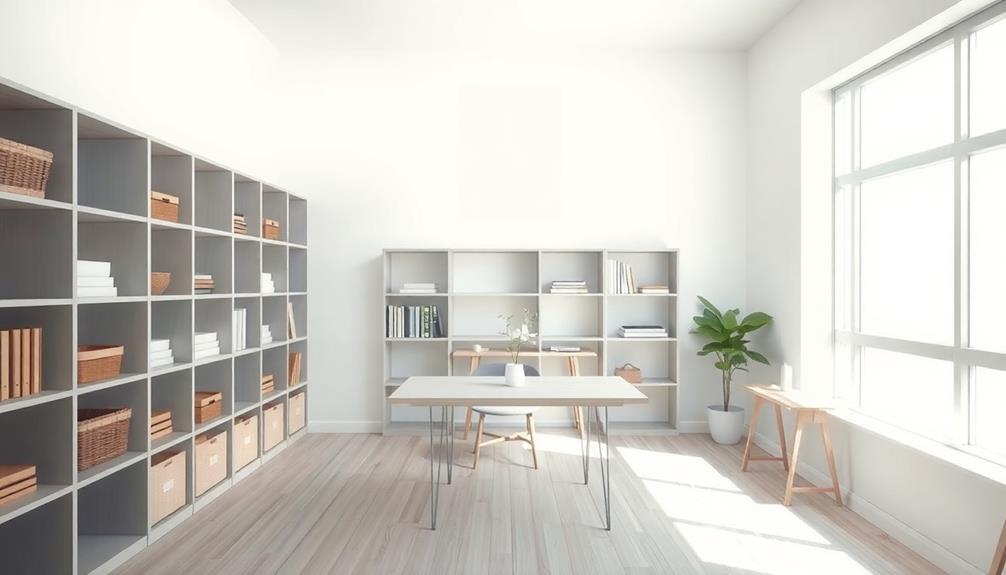
A clutter-free space is essential for maintaining the positive flow of energy (Chi) in your home. Clutter disrupts this flow, leading to stagnation that can affect your overall well-being. To create a balanced atmosphere, you should regularly organize and declutter your living areas. Focus on spaces like your living room and kitchen, where harmony among the five Feng Shui elements can greatly enhance aesthetic appeal and energy flow.
Consider the following strategies to maintain a clutter-free environment:
| Strategy | Benefits |
|---|---|
| Regular Decluttering | Promotes smoother energy movement |
| Holistic Layout Reevaluation | Supports a clutter-free lifestyle |
| Personal Adaptation of Feng Shui Principles | Tailors decluttering to your needs |
Incorporating Natural Light

After establishing a clutter-free environment, the next step in enhancing your Feng Shui is incorporating natural light.
Natural light plays a crucial role in improving the energy flow (Chi) within your space, uplifting your mood, and promoting overall well-being.
Additionally, integrating elements of traditional artistry, such as Indonesian decor masks, can further enhance the ambiance of your home while celebrating cultural heritage.
Here are some effective ways to maximize natural light in your home:
- Optimize Window Placement: Confirm your windows are positioned to capture the most daylight, enhancing brightness and harmony in your space.
- Use Mirrors: Strategically placed mirrors can reflect and amplify natural light, making your rooms feel larger and more inviting while boosting positive energy.
- Choose Light Colors: Incorporating light, airy colors in your decor allows sunlight to reflect beautifully, enhancing the warmth and brightness of your environment.
- Keep Windows Clean: Regularly cleaning your windows confirms unobstructed light entry, improving both the aesthetic appeal and positive energy flow throughout your home.
Personalizing Your Space

Personalizing your space is fundamental for cultivating a harmonious environment that reflects who you are. When you incorporate elements that resonate with your personality and aspirations, like using green for growth or red for passion, you create a powerful connection to your surroundings.
Think about adding decor that showcases your values—art pieces or symbols that embody your goals can make your space feel more meaningful. Consider integrating unique items like a Face Indonesian Decor Mask which represents rich Indonesian cultural heritage, as this can enhance your home decor aesthetics while encouraging appreciation for traditional craftsmanship.
To enhance the energy in your home, consider the earth element through natural materials like wood and stone, which foster grounding and stability. The wood element introduces liveliness and growth, while water features can enhance tranquility and flow.
These elements not only beautify your space but also support your emotional well-being.
Maintaining a clutter-free environment is essential for personalizing your space, as it allows Chi to flow freely, promoting clarity and focus. You might also use a Bagua map to identify areas in your home that correspond to different aspects of your life, like career or relationships, enabling you to design your interiors to support those areas.
Frequently Asked Questions
What Are the 5 Elements of Feng Shui?
The five elements of Feng Shui are Wood, Fire, Earth, Metal, and Water. Each element's unique qualities influence your space's energy, promoting harmony and balance that can enhance your overall well-being and atmosphere.
What Are the Interior Elements of Feng Shui?
When creating your space, focus on incorporating elements like Wood, Fire, Earth, Metal, and Water. Each element brings unique energy, enhancing your environment's harmony, liveliness, and balance, ultimately fostering a more inviting atmosphere.
What Are the 5 Principles of Feng Shui?
You'll find the five principles of Feng Shui focus on balance, commanding position, decluttering, color psychology, and maximizing natural light. These elements help create a harmonious environment that enhances your well-being and energy flow.
What Is the 5 Elements Rule?
Imagine a garden thriving with diverse plants; that's the 5 Elements Rule in Feng Shui. It harmonizes Wood, Fire, Earth, Metal, and Water, creating balance and positive energy flow to enhance your well-being and environment.
Conclusion
By embracing the key elements of Feng Shui in your interiors, you'll create a harmonious sanctuary that nurtures both body and spirit. Balance, color, and natural light work together like a well-tuned orchestra, inviting positive energy into your home. Remember, it's not just about aesthetics; it's about crafting a space that resonates with your soul. So, take these principles to heart, personalize your environment, and watch as tranquility flows effortlessly through your life.
- About the Author
- Latest Posts
Introducing Ron, the home decor aficionado at ByRetreat, whose passion for creating beautiful and inviting spaces is at the heart of his work. With his deep knowledge of home decor and his innate sense of style, Ron brings a wealth of expertise and a keen eye for detail to the ByRetreat team.
Ron’s love for home decor goes beyond aesthetics; he understands that our surroundings play a significant role in our overall well-being and productivity. With this in mind, Ron is dedicated to transforming remote workspaces into havens of comfort, functionality, and beauty.
Southeast Asia Decor
Unveiling Surprising Feng Shui Color Secrets
Get ready to discover how the right colors can transform your space and elevate your energy—what secrets await you inside?
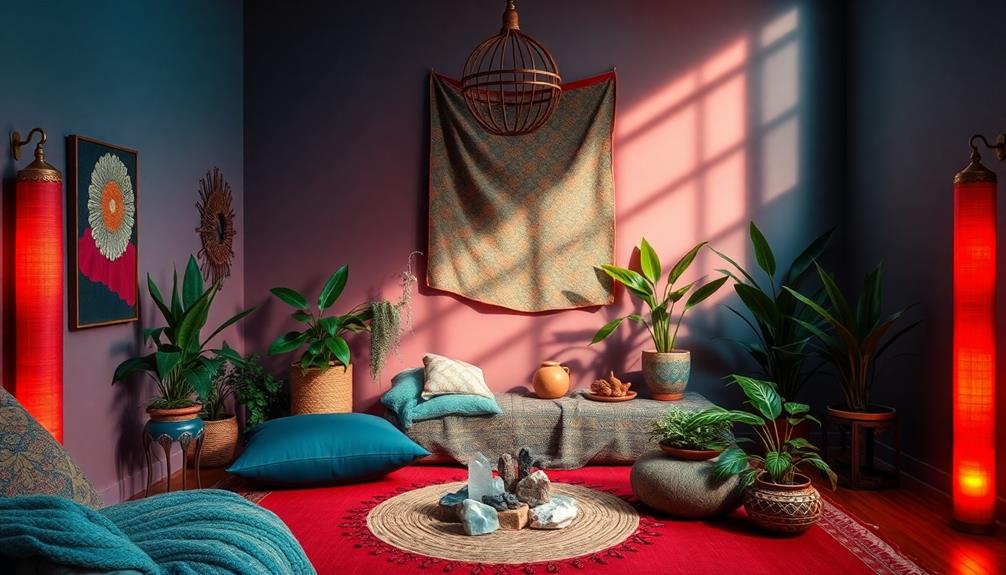
Revealing Feng Shui color secrets can drastically enhance your space. Each color affects your emotions and energy flow differently. For instance, red energizes and attracts luck, while blue promotes tranquility—perfect for bedrooms. Green encourages growth and liveliness, ideal for communal areas. Warm colors stimulate creativity, while earthy tones offer stability. By selecting shades that resonate with your intentions, you can create a supportive environment. Don't forget to take into account seasonal adjustments to keep your space harmonious throughout the year. If you're curious about applying these principles effectively, there's even more insightful information waiting for you.
Key Takeaways
- Color choices in Feng Shui can significantly affect emotional well-being and energy flow, enhancing overall harmony in living spaces.
- Each color corresponds to specific elements; for instance, red symbolizes passion while blue promotes tranquility, influencing the intended atmosphere.
- Incorporating gold and purple in decor can attract wealth and abundance, aligning with Feng Shui principles for prosperity.
- Seasonal color adjustments, like warm autumn tones or cool winter shades, promote balance and reflect the changing energy throughout the year.
- Personal preferences and intentions should guide color selections, ensuring spaces resonate with individual energy for optimal well-being.
The Essence of Feng Shui
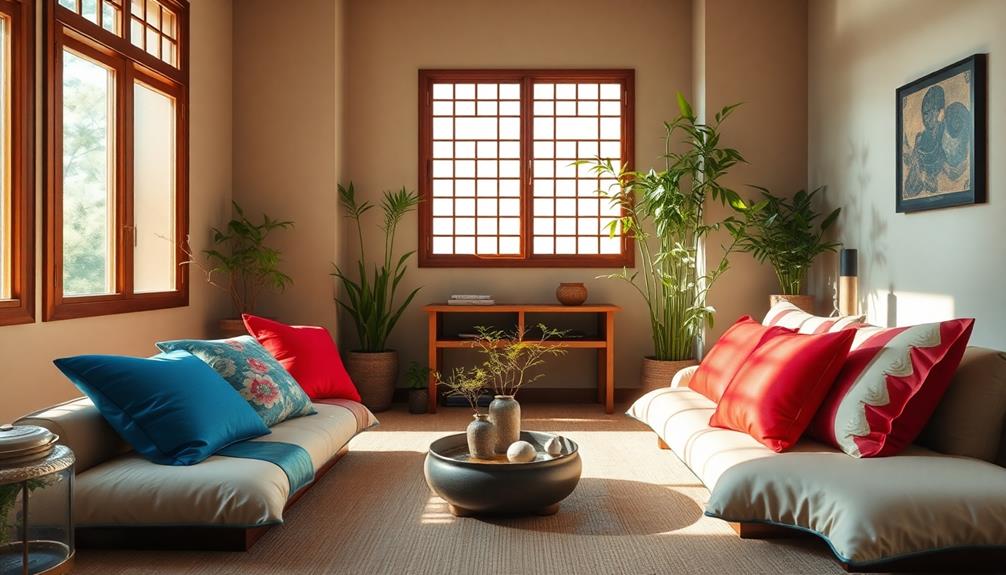
Feng Shui is more than just an arrangement of furniture; it's an ancient practice rooted in creating harmony and balance in your environment. By applying Feng Shui principles, you can enhance the flow of positive energy, or chi, in your space.
One of the essential aspects of this practice involves understanding how different paint colors affect your atmosphere and emotional well-being. Incorporating elements of traditional Indonesian style home decor can further enrich your space, as it emphasizes harmony with nature and the use of natural materials.
The five elements of Feng Shui—Wood, Fire, Earth, Metal, and Water—correspond to specific colors, each influencing the energy of a room. For instance, red, linked to the Fire element, symbolizes luck and passion, while blue, associated with Water, promotes tranquility and calmness.
Choosing the right paint colors for your walls isn't just about aesthetics; it's about creating a supportive environment that nurtures your goals.
Using the Bagua map, you can identify which color enhances specific areas of your life, like health or wealth. Remember, clutter disrupts chi, so decluttering is crucial.
Color Psychology in Feng Shui

In Feng Shui, each color carries specific meanings that can affect your emotions and energy at home or work.
For instance, incorporating vibrant colors and intricate patterns through Indonesian decorative pillows can enhance your living spaces, providing comfort while reflecting cultural heritage.
By choosing colors intentionally, you can harness their unique properties to enhance your well-being and achieve your desired outcomes.
Let's explore how understanding color psychology can transform your space and elevate your life.
Color Meanings Explained
Colors play an essential role in shaping the energy and emotional environment of a space. Each color carries distinct meanings that can influence your feelings and the overall atmosphere.
For instance, red is all about luck and passion, making it a powerful choice for energizing a room. In Balinese interior design, vibrant colors can be integrated harmoniously with natural materials to create a lively yet tranquil environment, exemplifying the use of traditional Balinese motifs.
If you're seeking tranquility, blue is perfect; it promotes calmness and helps you unwind.
Green symbolizes growth and liveliness, enhancing health and well-being, which makes it ideal for natural settings. If happiness and positivity are what you want to cultivate, yellow is your go-to color—it creates a welcoming atmosphere that stimulates cheerfulness and intellectual engagement.
Earth tones like beige and terracotta provide grounding, fostering security and comfort, especially in outdoor spaces.
On the other hand, white and gray represent purity and balance, reflecting light beautifully and adding sophistication to interiors when paired with other colors.
Choosing Colors Intentionally
Understanding how colors affect your emotions can be a powerful tool in creating a harmonious environment. In Feng Shui, color psychology plays a significant role in shaping the energy flow within your space. Each color resonates with specific emotions and energies, enabling you to intentionally select hues that align with your desired atmosphere.
For instance, if you're looking to spark passion or excitement, incorporating red as an accent color can stimulate social interactions. Additionally, incorporating culturally significant decor elements like traditional artistry can enhance the overall aesthetic and emotional impact of your space.
On the other hand, green embodies growth and renewal, making it perfect for living rooms or gardens where you want to foster liveliness and health. If you need a boost of cheerfulness and intellectual stimulation, yellow is an excellent choice for kitchens or study areas, creating a welcoming vibe.
The Impact of Color Choices
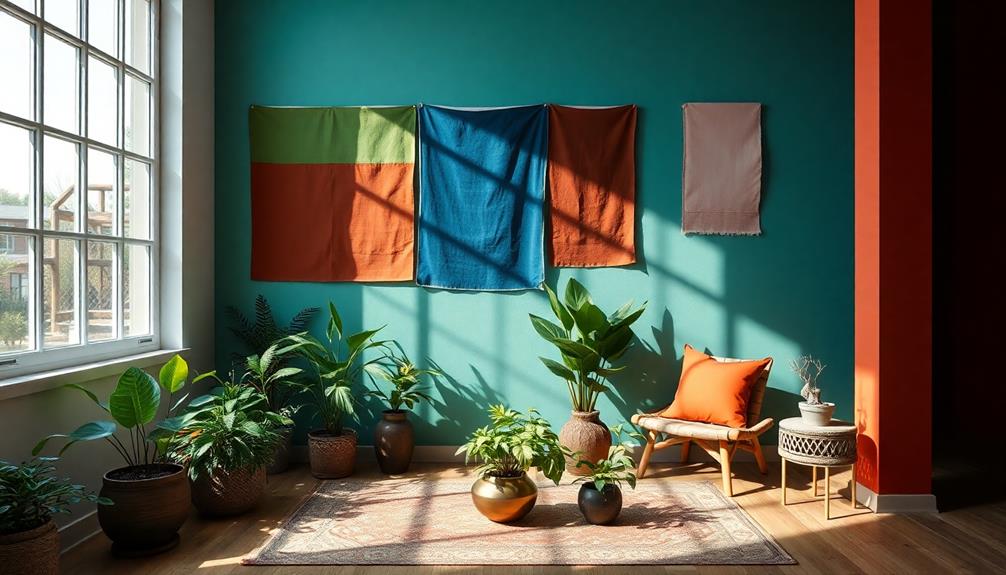
Harmony in your living space can be profoundly influenced by your color choices. Each hue corresponds to one of the five elements in Feng Shui, greatly impacting the energy flow and emotional atmosphere of your home. For example, red ignites passion and excitement, while blue fosters tranquility and calmness. Incorporating elements like cultural decor enthusiasts can further enhance the aesthetic appeal of your space.
Understanding these associations helps you create a space that resonates with your desired feelings. The placement and orientation of colors also play an essential role. Light colors can enhance warmth and openness, while dark colors might create a sense of heaviness.
Thus, when you're selecting colors, consider how they'll interact with the space and the energy you want to cultivate. Your personal preferences and moods should guide these color choices to guarantee they align with your emotional needs.
If you're unsure about your selections, consulting with a certified Architectural Color Consultant can be beneficial. They can help you optimize your color choices, making sure they align with Feng Shui principles for improved energy flow and visual appeal.
Colors for Health and Well-Being
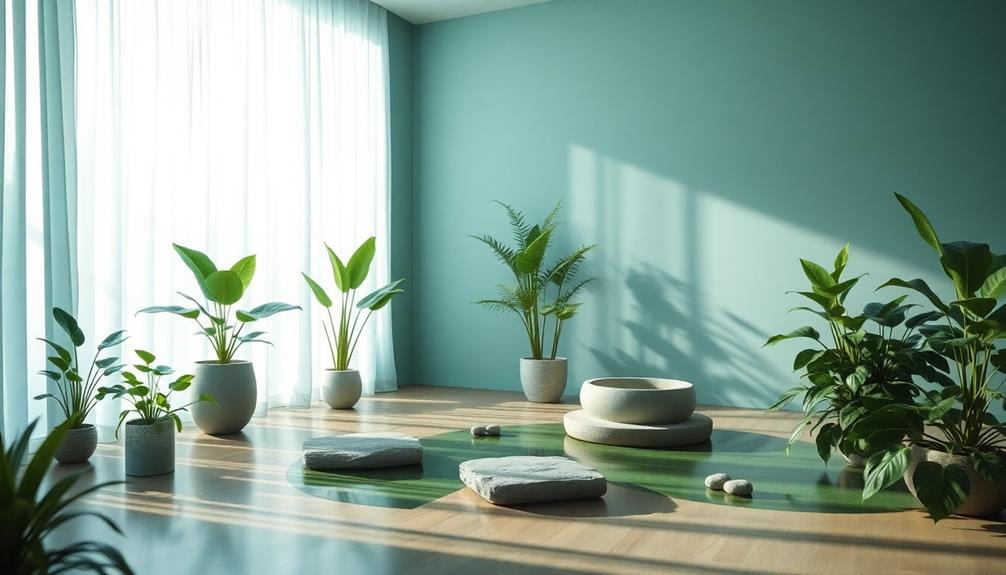
Your choice of colors can considerably enhance your health and well-being, creating spaces that nurture both your body and mind. By understanding the impact of various shades, you can create an environment that promotes positive outcomes.
Here's a quick reference to help you select the right colors for health and well-being:
| Color | Benefits | Ideal Spaces |
|---|---|---|
| Green | Growth and liveliness | Health-focused areas |
| Yellow | Clarity, optimism, and creativity | Workspaces, playrooms |
| Soft Blue | Tranquility and relaxation | Bedrooms, meditation spaces |
| Earthy Tones | Stability and grounding | Living rooms, entryways |
Incorporating these colors into your home can lead to significant improvements in your emotional and physical health. For example, vibrant colors can be used sparingly as accents to stimulate energy and joy, while earthy tones create a sense of security. Soft blues promote peace essential for emotional health. By thoughtfully choosing colors, you can transform your environment into a sanctuary that supports your overall well-being.
Enhancing Wealth Through Color

How can the right colors transform your financial landscape? In Feng Shui, the colors you choose can notably impact your wealth.
Start by incorporating purple into your decor. This color symbolizes luxury and abundance, making it a powerful choice for attracting prosperity.
Luxury tropical designs can further enhance this ambiance, creating serene spaces that foster a positive financial flow. Gold, representing richness, can enhance financial success and attract wealth energy—consider using gold accents for a touch of opulence.
Green is another essential color, linked to growth and liveliness. When placed in areas associated with wealth, like the southeast corner of your home, it encourages financial expansion.
Don't overlook red; this vibrant hue ignites energy and passion, stimulating wealth opportunities and inviting good fortune into your financial endeavors.
Lastly, black can create sophistication and depth in your space. When combined thoughtfully with other colors, it fosters an elegant atmosphere conducive to wealth accumulation.
By strategically using these colors, you can cultivate an environment that not only supports your financial aspirations but also attracts the wealth energy you desire.
Embrace these Feng Shui color secrets and watch how your financial landscape transforms!
Relationship Colors and Their Meanings

Exploring the colors tied to relationships can reveal powerful insights into enhancing your romantic life. Each color carries unique meanings that can help you foster connection and harmony with your partner. Understanding these relationship colors allows you to create a more inviting and loving atmosphere.
| Color | Meaning |
|---|---|
| Pink | Symbolizes love and romance, promoting affection and harmony. |
| Red | Represents passion, excitement, and energy, sparking romantic energy. |
| White | Signifies purity and new beginnings, fostering clarity and communication. |
| Green | Encourages growth and renewal, nurturing emotional connections. |
| Yellow | Promotes joy and optimism, enhancing positive interactions. |
Color Combinations for Harmony
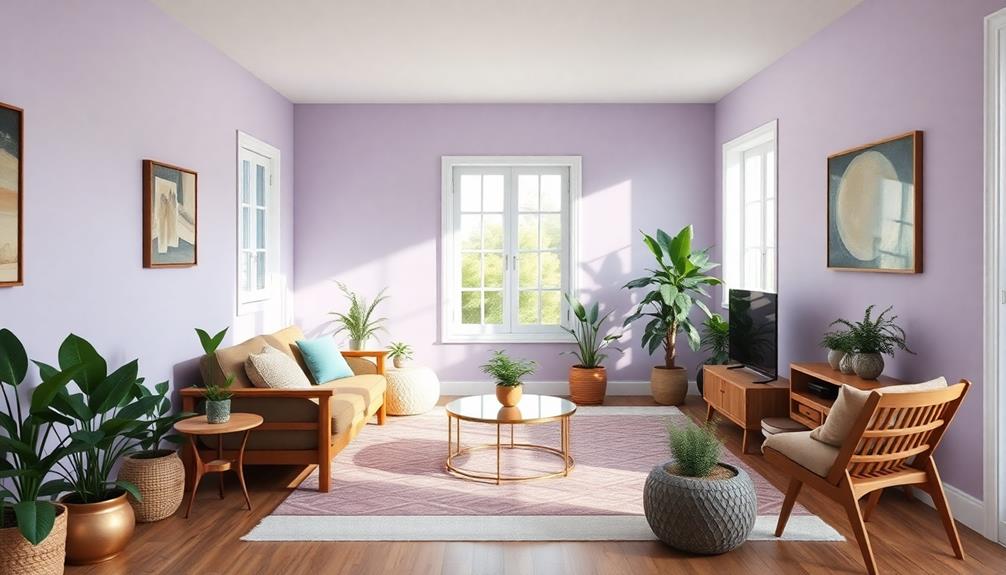
When you think about color combinations for harmony, consider how complementary pairings can enhance your space.
For instance, using a neutral color palette accented with vibrant hues can create a serene yet lively atmosphere, reminiscent of tropical villa designs.
Balancing warm and cool tones not only creates visual interest but also influences your mood.
Understanding the symbolic meanings of colors will help you choose combinations that promote the energy you want in your home.
Complementary Color Pairings
Complementary color pairings can transform your space by creating a harmonious balance that resonates with Feng Shui principles. By using colors from opposite sides of the color wheel, you can enhance the energy flow in your home. Here are some effective combinations to contemplate:
| Complementary Color Pairing | Ideal Space |
|---|---|
| Blue and Orange | Living Room |
| Green and Red | Home Office |
| Beige and Deep Blue | Bedroom |
| Yellow and Purple | Study Area |
Pairing blue with orange brings tranquility and warmth, making it perfect for social areas. Green and red symbolize growth and liveliness, igniting passion in energetic spaces like a living room or office. For restful sleep, earthy tones like beige with deep blue foster stability and calmness in bedrooms. Finally, using yellow alongside purple enhances intellectual stimulation and creativity, ideal for study areas.
Incorporating these complementary colors not only boosts your space's aesthetic appeal but also optimizes energy flow, aligning with Feng Shui principles to enhance your overall well-being. Embrace these pairings for a more harmonious environment!
Balancing Warm and Cool
Achieving a harmonious balance in your space means blending warm and cool colors effectively. By combining warm colors like red and yellow with cool colors such as blue and green, you can create harmony that stimulates energy while promoting tranquility.
Incorporating traditional motifs, inspired by Indonesian wedding decor, can further enhance the cultural significance of your color choices. Warm colors, connected to the Fire element, encourage social interactions and creativity, while cool colors, linked to Water, foster calmness and serenity.
To enhance specific areas of life represented in the Bagua map, use strategic color combinations. For instance, warm colors in the wealth corner can attract abundance, while cool colors in the family area can nurture harmony.
Incorporating neutral colors like whites and grays as a base can provide a grounding effect, allowing vibrant warm and cool colors to stand out without overwhelming the space.
Understand the psychological impacts of these color combinations; warm tones can evoke excitement, while cool hues instill relaxation and peace.
Symbolic Color Meanings
Colors carry powerful symbolic meanings in Feng Shui, influencing the energy of your space. Understanding these meanings allows you to apply the principles of Feng Shui effectively.
For instance, warm colors like red and yellow stimulate creativity and passion, making them ideal for your workspace, which can also be reflected in vibrant color palettes inspired by Indonesian culture. On the other hand, cool colors such as blue and green promote tranquility and balance, perfect for bedrooms or meditation areas.
Combining earth tones like terracotta or beige with bright colors like yellow can create a grounding and inviting environment, enhancing feelings of security and warmth. If you want to make a bold statement, consider using contrasting colors such as black and white. This combination creates a sophisticated and dynamic energy, balancing depth and clarity.
Furthermore, incorporating metallic colors like gold or silver with earth tones can infuse your space with elegance and abundance, reinforcing positive energy and prosperity.
Personalizing Your Color Palette
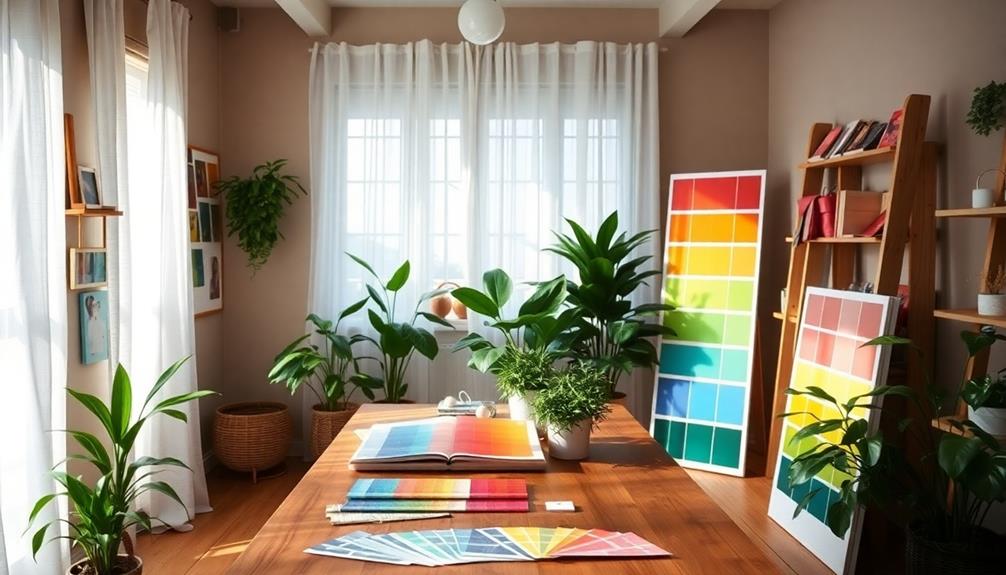
When it comes to personalizing your color palette in Feng Shui, it's crucial to choose hues that truly resonate with your emotions and aspirations. Start by evaluating your personal energy and intentions. This way, you can select colors that align with what you want to attract in your life.
Incorporating shades from the Five Elements can enhance specific energies; for instance, greens and browns promote growth and stability, while reds and purples evoke passion and luxury. Additionally, consider the architectural styles of your home, as they can influence the overall ambiance and flow of energy within your space. Traditional Indonesian housing, for example, often incorporates natural materials and elevated structures that can harmonize beautifully with specific color choices traditional Indonesian housing.
Don't forget that light changes throughout the day can alter how colors appear in your space. Make sure to view color samples at different times to understand their true impact.
If you're designing a child's room, involve them in the color selection process. This can create a vibrant and personalized space that boosts their self-esteem and creativity.
For more guidance, consider consulting a certified Architectural Color Consultant. Their expertise can help you create a harmonious color palette that not only looks good but also promotes good Feng Shui, enhancing your overall well-being and living experience.
Personalizing your color palette can transform your environment into a sanctuary that reflects who you are.
Seasonal Color Adjustments

Feng Shui's seasonal color adjustments can greatly enhance the energy of your space by aligning it with nature's rhythms. Each season brings unique energies that can be reflected in your interior colors, promoting harmony and balance.
In spring, consider incorporating light and pastel colors like soft greens and yellows. These hues symbolize renewal and growth, fostering liveliness and optimism in your environment.
As summer rolls in, vibrant colors such as bold reds and oranges energize your space, reflecting warmth and stimulating social interactions.
When autumn arrives, embrace earthy tones like browns and golds. These colors provide stability and grounding, mirroring nature's change as it prepares for winter.
Practical Tips for Color Application

Choosing the right colors for your space involves more than just picking your favorites; it requires careful consideration of various factors to achieve the desired atmosphere.
Start by examining how natural light affects your colors throughout the day. Viewing samples in different lighting conditions helps you avoid surprises. Use quality paint samples for a more accurate representation of how the color will look on your walls.
Next, think about how colors resonate with your personal preferences and moods. Selecting shades that uplift you can create a more positive and satisfying environment. For entranceways, light colors promote warmth and a welcoming vibe, while darker hues can feel heavy if overused.
If you want to align your choices with Feng Shui principles, consider consulting a certified Architectural Color Consultant. They can guide you in selecting colors that not only enhance the energy flow in your space but also create a harmonious atmosphere.
Frequently Asked Questions
What Colors Should Be Avoided in Feng Shui?
You should avoid using excessive black, dark colors, bright white, and red in your spaces. These can create heaviness, coldness, or overstimulation, disrupting the energy flow and making your environment feel unwelcoming or chaotic.
What Color Evokes Wealth?
When it comes to evoking wealth, you can't go wrong with purple and green. They symbolize luxury and growth, respectively. Incorporating gold or red can also spark financial opportunities in your space.
What Color Attracts Wealth?
To attract wealth, consider using green for its growth symbolism, purple for luxury, and gold for success. Incorporate these colors thoughtfully, along with plants or water features, to enhance your prosperity potential.
What Colour Attracts Good Luck?
While luck can seem elusive, colors like red and green invite it in. You'll find joy in red's vibrancy and growth in green's calm. Choose wisely, and you'll attract the fortune you seek.
Conclusion
By embracing these surprising Feng Shui color secrets, you can paint your life with harmony and vibrancy. Picture your space as a canvas, where each hue whispers to your well-being, prosperity, and balance. As you blend colors thoughtfully, you'll cultivate an atmosphere that nourishes your spirit and invites abundance. So go ahead, release your creativity—let your walls tell a story that reflects your unique journey, and watch as your environment transforms into a sanctuary of positivity.
- About the Author
- Latest Posts
Introducing Ron, the home decor aficionado at ByRetreat, whose passion for creating beautiful and inviting spaces is at the heart of his work. With his deep knowledge of home decor and his innate sense of style, Ron brings a wealth of expertise and a keen eye for detail to the ByRetreat team.
Ron’s love for home decor goes beyond aesthetics; he understands that our surroundings play a significant role in our overall well-being and productivity. With this in mind, Ron is dedicated to transforming remote workspaces into havens of comfort, functionality, and beauty.
Southeast Asia Decor
Feng Shui Color Schemes Vs Traditional Indonesian Design
How do Feng Shui color schemes differ from traditional Indonesian design in creating harmonious spaces? Discover the unique elements that shape these styles.

When comparing Feng Shui color schemes to traditional Indonesian design, you'll find distinct approaches. Feng Shui emphasizes the flow of Qi, using specific colors to enhance emotions and well-being based on natural elements. In contrast, traditional Indonesian design celebrates vibrant colors that reflect cultural heritage, using earthy tones and bold patterns that connect to nature. Both styles prioritize harmony, but they differ in emotional focus and aesthetic goals. By understanding these differences, you can create spaces that resonate with your values and lifestyle, guiding you to design choices that reflect your unique perspective. There's much more to discover on this topic.
Key Takeaways
- Feng Shui emphasizes color associations with the Five Elements, influencing emotional well-being and Qi flow in spaces.
- Traditional Indonesian design features vibrant colors reflecting cultural heritage and community significance, often derived from local materials.
- Feng Shui promotes balanced color combinations to harmonize living spaces, while Indonesian design often embraces bold, expressive palettes.
- Both design philosophies utilize natural materials, but Feng Shui focuses on optimizing energy flow, whereas Indonesian design highlights cultural storytelling.
- Future trends in both fields increasingly incorporate sustainability, merging eco-friendly practices with traditional and modern aesthetic values.
Overview of Feng Shui Principles
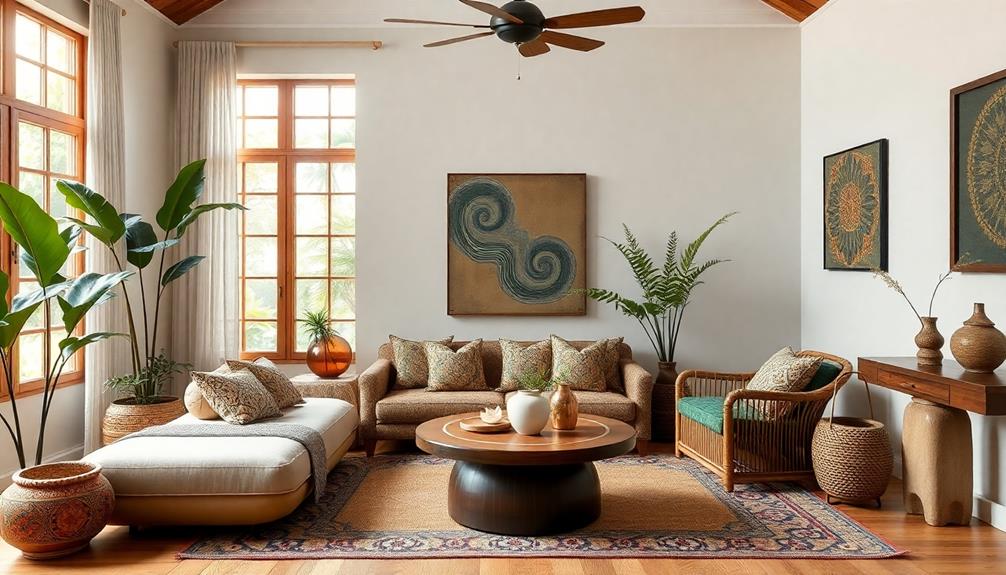
Have you ever wondered how your environment affects your well-being? In Feng Shui, the principles focus on the flow of Qi, or cosmic energy, emphasizing how your surroundings can harmonize with your life.
By using Feng Shui Color and the Five Elements—wood, fire, earth, metal, and water—you can enhance the energy of your spaces. Each color corresponds to a natural element, influencing the atmosphere of your home. For example, red, associated with fire, brings energy and passion, while blue, linked to water, promotes tranquility and healing.
Incorporating elements like Indonesian decorative pillows can further enrich the vibrancy of your interiors, marrying cultural heritage with Feng Shui principles.
Feng Shui principles guide you in selecting colors based on their directional elements. This means certain colors can enhance specific areas of your home, creating a balance that fosters emotional well-being and productivity.
By strategically placing items and incorporating natural materials like plants and water features, you can optimize the flow of Qi in your environment. Ultimately, Feng Shui seeks to harmonize human design with nature, ensuring that positive energy flows freely, enhancing your overall quality of life.
Embracing these principles can lead to a more balanced, peaceful, and vibrant living space.
Key Elements of Indonesian Design
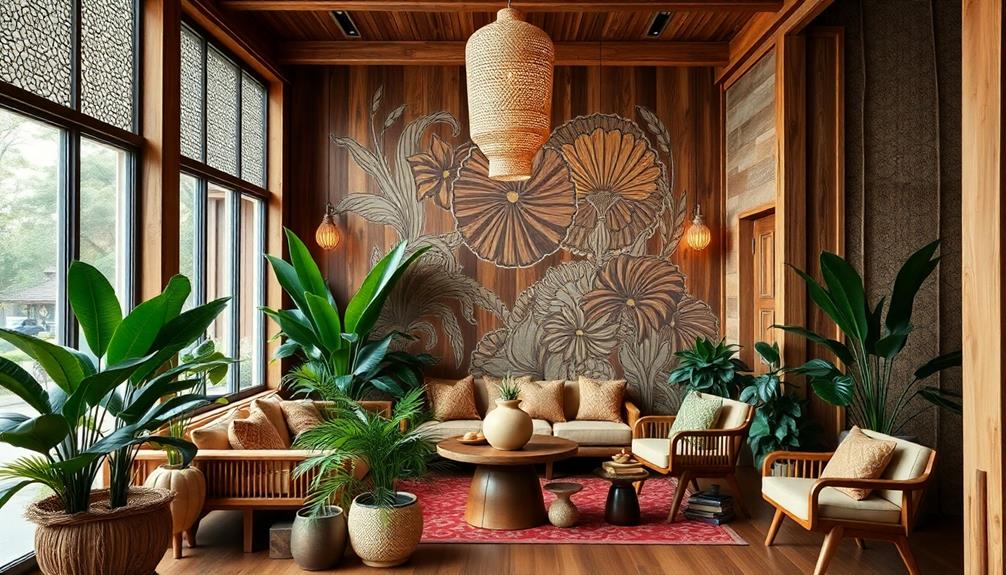
Indonesian design is a vibrant tapestry woven from the country's rich cultural heritage, with influences from various ethnic groups like the Javanese, Balinese, and Minangkabau. This unique blend creates a distinctive aesthetic that reflects local customs and beliefs.
When exploring the key elements of Indonesian design, you'll notice several impactful features:
1. Natural Materials: Wood, bamboo, and stone are prevalent, emphasizing a connection to nature. The use of the Wood Element not only showcases craftsmanship but also harmonizes interiors with the surrounding environment.
In Balinese interior design concepts, natural materials are particularly emphasized for their calming effects.
2. Open Layouts: Traditional Indonesian homes often feature spacious, communal areas that encourage social interaction. This design principle fosters a sense of community, contrasting with the more compartmentalized Western approach.
The integration of open spaces also enhances indoor-outdoor living, a hallmark of Balinese aesthetics.
3. Decorative Artistry: Batik fabrics and traditional masks adorn interiors, telling stories and showcasing regional artistry.
These decorative elements enhance the aesthetic appeal while reflecting cultural significance.
Color Significance in Feng Shui
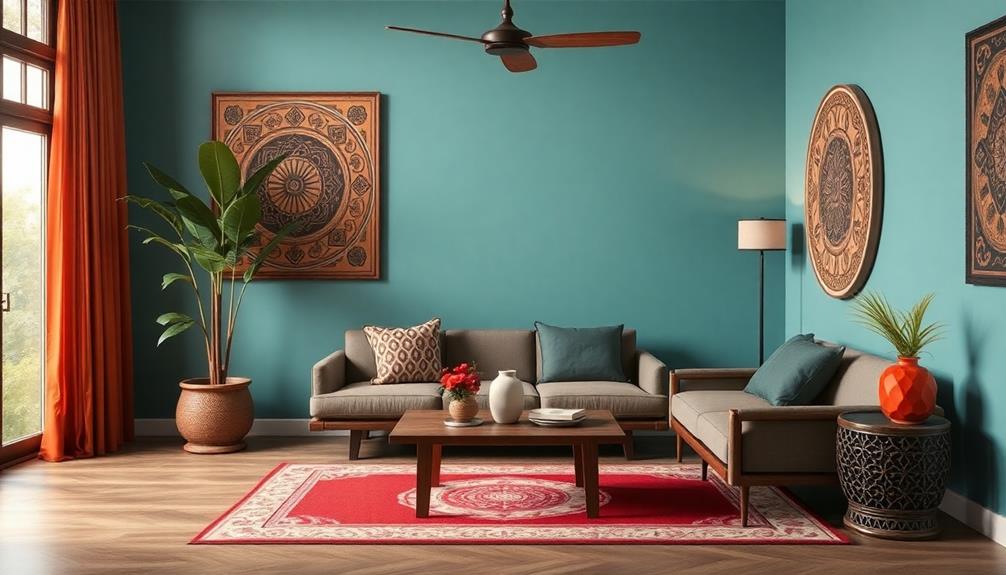
In Feng Shui, the colors you choose can greatly impact your emotions and overall well-being. Each color is tied to specific elements and areas of life, influencing how you experience your space.
For instance, the vibrant artistry found in Indonesian decor masks reflects rich cultural heritage, which can enhance the emotional resonance of a room.
Understanding these associations can help you create a harmonious environment that resonates with your personal and cultural interpretations of color.
Emotional Impact of Colors
Colors play an essential role in shaping your emotional environment, especially in Feng Shui, where each hue carries specific meanings and influences. Understanding color psychology can help you create spaces that promote positive Shui energy and emotional well-being.
In traditional Indonesian design, colors are often chosen to reflect harmony with nature and local culture, enhancing the overall ambiance of the space. By integrating elements of traditional Indonesian style home decor, you can further enrich your environment.
Here are three key color impacts to take into account:
- Red: Symbolizing luck and passion, red can invigorate your space, boosting energy and motivation.
- Blue: Known for its calming properties, blue promotes tranquility and healing, making it perfect for relaxation areas like bedrooms.
- Orange: Associated with the Earth element, orange fosters stability and nurturing, creating a warm, inviting atmosphere.
When you carefully select colors, you can intentionally evoke specific emotions. Soft, harmonious colors enhance comfort and relaxation, while high contrast shades may lead to restlessness.
Balancing bold colors with neutrals is vital to maintaining harmony in your interior spaces. By experimenting with innovative color combinations, you can tailor your environment to meet your emotional needs effectively.
Ultimately, the right colors can greatly influence your mood, helping you cultivate a serene and balanced living space.
Elemental Color Associations
How can understanding elemental color associations in Feng Shui enhance your living spaces? By incorporating the right color scheme based on the five elements, you can create environments that resonate with specific energies.
For instance, integrating vibrant colors like those found in traditional Indonesian decor masks can add depth and cultural meaning to your home while complementing Feng Shui principles.
The Water element, represented by shades of blue or black, evokes tranquility and healing, perfect for calming spaces like bedrooms or meditation areas. If you want to inspire creativity and wellness, consider the Wood element's shades of green, symbolizing growth and liveliness.
For a burst of passion and energy, integrate Fire colors—red, maroon, burgundy, and hot pink—into your design. If stability and nourishment are what you seek, Earth tones like orange, yellow, and brown will serve you well, especially in relaxation zones.
Cultural Color Interpretations
Understanding the importance of colors in different cultural contexts adds layers to your design choices. In Feng Shui, colors play a crucial role, symbolizing elements that influence emotional responses and energy flow.
For instance, red ignites passion and luck, while blue promotes tranquility and healing. Additionally, incorporating elements like Indonesian decor masks can enhance the cultural depth of your space, as they often embody unique artistry and storytelling that resonates with color symbolism in local traditions, such as the rich cultural heritage of Indonesia.
Here's how you can interpret colors in Feng Shui:
- Green – Represents growth and renewal.
- Yellow – Symbolizes optimism and clarity.
- Orange/Brown – Associated with stability and nourishment.
In contrast, traditional Indonesian design embraces vibrant colors rooted in cultural symbolism. While red might signify courage and strength, yellow can represent prosperity and warmth.
The emotional weight of these colors diverges greatly from Feng Shui interpretations. Where Feng Shui emphasizes harmony and balance, Indonesian traditions often reflect deeper connections to community, identity, and spirituality.
Traditional Indonesian Color Palettes

Traditional Indonesian design showcases a stunning array of vibrant colors that reflect the rich cultural tapestry of the archipelago. You'll find deep reds, yellows, and earthy browns derived from local materials, each representing the diverse customs and beliefs across the regions.
For example, the architectural styles of traditional Indonesian housing vary greatly by region, influencing color choices. Batik, a traditional fabric-dyeing technique, features intricate patterns in bold colors, allowing you to explore the unique color palettes of each locality.
Using natural dyes from plants, minerals, and insects, Indonesian textiles present a wide spectrum of colors, like indigo, turmeric yellow, and crimson from the lac insect.
When you walk into a traditional Indonesian home, you'll notice the warm and earthy tones that create inviting spaces, emphasizing harmony with the natural environment.
The cultural significance of colors plays a key role in traditional architecture too. For instance, red symbolizes courage and strength, while green represents fertility and prosperity.
To truly appreciate these vibrant palettes, consider how natural light interacts with the colors throughout the day. This connection enhances the overall beauty and meaning, encouraging you to use color in a way that honors both tradition and the environment.
Integrating Feng Shui With Indonesian Design

Integrating Feng Shui with Indonesian design creates a harmonious blend of cultural aesthetics and energy principles that enhance your living space.
By marrying these two approaches, you can achieve a balanced environment that promotes well-being and tranquility. Traditional motifs and patterns found in Indonesian Wedding Decor can be beautifully incorporated into your design to enhance cultural significance.
Here are three key ways to achieve this integration:
- Natural Elements: Use earthy tones and natural materials in your decor to ground your space. This aligns perfectly with Feng Shui's focus on stability and health, while also respecting the beauty of Indonesian design.
- Open Spaces: Embrace open layouts and maximize natural light. This not only enhances the aesthetic appeal but also encourages the flow of chi, making your home feel more vibrant and alive.
- Strategic Placement: Arrange your furniture and decor thoughtfully. Utilize Feng Shui principles to create areas that foster social interaction and emotional well-being, while still honoring traditional Indonesian design elements.
Future Trends in Color Design
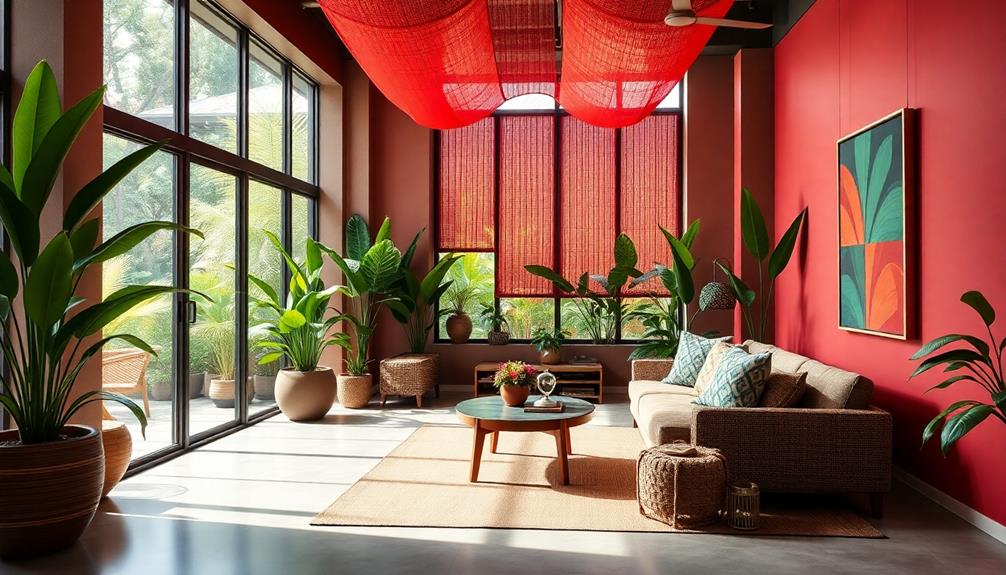
As you explore future trends in color design, you'll notice a shift toward sustainable material innovations that cater to eco-conscious consumers.
This trend aligns with the principles of tropical contemporary house design, where integrating natural elements and vibrant hues reflects cultural heritage and enhances well-being.
Additionally, cultural color interpretations are becoming more prominent, allowing you to create spaces that resonate deeply with diverse traditions and values.
This blend of sustainability and cultural awareness can elevate your design projects to new heights.
Sustainable Material Innovations
Sustainable material innovations are transforming the landscape of color design, making it more eco-conscious than ever.
You'll find that designers are increasingly opting for sustainable materials that align with both aesthetic values and environmental responsibility. Significantly, luxury tropical designs are incorporating these sustainable practices to enhance both beauty and functionality.
As you explore these trends, consider the following:
- Eco-friendly pigments: Derived from natural sources like plants and minerals, these pigments offer vibrant color options while minimizing environmental impact.
- Recycled materials: Using recycled elements in your design not only supports a circular economy but also reduces waste, making your space both stylish and sustainable.
- Low-VOC options: Advances in technology have brought about low-VOC paints and finishes that enhance indoor air quality without sacrificing color vibrancy, essential for feng shuis.
Incorporating biodegradable and upcycled materials into color design allows you to create beautiful spaces while telling a story of sustainability.
By embracing these innovations, you're not just enhancing your environment; you're contributing to a healthier planet.
As you make design choices, keep in mind the positive impact of choosing sustainable materials.
Cultural Color Interpretations
The interplay between cultural color interpretations and design is gaining momentum as designers seek to blend traditional motifs with modern aesthetics. In Indonesia, vibrant colors like red, yellow, and green signify deeper cultural meanings, while Feng Shui relies on elemental color associations to enhance energy flow.
As design trends evolve, you'll notice a shift towards earthy tones that reflect sustainability, mirroring Feng Shui's principles of balance. This fusion leads to innovative spaces that honor both heritage and harmony.
Here's a look at some key color interpretations:
| Design Aspect | Color Interpretation |
|---|---|
| Traditional Indonesian | Vibrant colors symbolize life and spirituality |
| Feng Shui | Colors enhance energy flow based on elements |
| Modern Trends | Earthy tones promote sustainability and harmony |
| Future Fusion | Blending minimalist aesthetics with heritage hues |
Integrating batik patterns further enriches this dialogue, allowing for unique combinations inspired by folklore. As you explore these cultural nuances, you'll find that future color palettes will likely incorporate natural hues and textures, fostering a deeper environmental consciousness.
Frequently Asked Questions
What Colors Should Be Avoided in Feng Shui?
In Feng Shui, you should avoid excessive greens and blues in the east and southeast sectors, black in the south, and overly bright colors everywhere. These choices can disrupt elemental balance and negatively impact your life.
What Is the Color Theory of Feng Shui?
Did you know that colors can influence your mood by up to 90%? In Feng Shui, color theory connects specific hues to emotions and life areas, helping you create harmony and balance in your environment.
What Role Does Color Play in Feng Shui Architecture?
In Feng Shui architecture, color plays an essential role in enhancing energy flow. You'll find specific hues promoting balance and emotional well-being, ensuring your space supports your goals, relationships, and overall harmony in daily life.
What Color Should I Paint My House in Feng Shui?
Imagine your house as a canvas; choosing the right colors paints harmony. For north-facing homes, embrace whites or grays. South-facing? Warm reds or greens ignite energy. Always remember, balance is key to a thriving space.
Conclusion
Incorporating Feng Shui principles with traditional Indonesian design can create a harmonious living space that resonates with both energy and culture. For instance, studies show that environments designed with thoughtful color schemes can boost productivity by up to 20%. By blending the vibrant colors of Indonesian design with the calming hues of Feng Shui, you can enhance the aesthetic and emotional balance of your home. Embracing both styles not only enriches your space but also nurtures your well-being.
- About the Author
- Latest Posts
Introducing Ron, the home decor aficionado at ByRetreat, whose passion for creating beautiful and inviting spaces is at the heart of his work. With his deep knowledge of home decor and his innate sense of style, Ron brings a wealth of expertise and a keen eye for detail to the ByRetreat team.
Ron’s love for home decor goes beyond aesthetics; he understands that our surroundings play a significant role in our overall well-being and productivity. With this in mind, Ron is dedicated to transforming remote workspaces into havens of comfort, functionality, and beauty.
-

 Retreat4 weeks ago
Retreat4 weeks agoDIY Aromatherapy Diffusers for a Spa-Like Atmosphere at Home
-

 Retreat3 weeks ago
Retreat3 weeks agoThe Business of Retreats: Marketing Strategies for Success
-
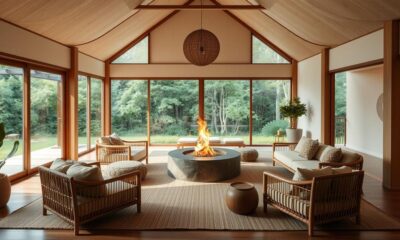
 Retreat3 weeks ago
Retreat3 weeks ago10 Unique Themed Room Ideas for Your Retreat Center
-

 Southeast Asia Decor3 weeks ago
Southeast Asia Decor3 weeks agoIndonesian Textiles Shaping Contemporary Interior Design
-

 Retreat1 week ago
Retreat1 week agoThe Pros and Cons of Different Retreat Center Business Models
-

 Retreat3 weeks ago
Retreat3 weeks agoThe Psychology of Color in Retreat Center Design
-

 Retreat4 weeks ago
Retreat4 weeks agoUnusual DIY Projects: Designing a Space Probe in Bitlife
-

 Retreat3 weeks ago
Retreat3 weeks agoHow to Host a Successful Wellness Retreat: A Complete Guide











